Get ready, Class 10 students! As you delve into the fascinating world of science in Chapter 10, "The Human Eye and The Colourful World," you're embarking on a journey that will not only pique your curiosity but also prepare you for the upcoming 2024-25 board exams. We've got you covered with comprehensive notes straight from the NCERT book. So, fasten your seatbelts, because we're about to unravel the secrets of the human eye and its enchanting relationship with the colorful world around us. Let's dive in!
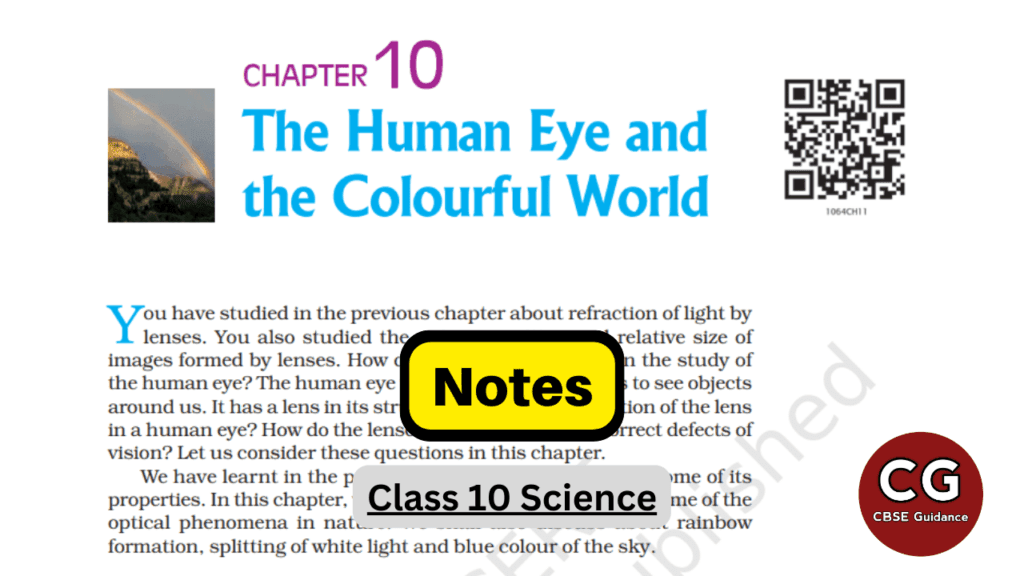
| Subject | Science |
| Class | 10 |
| Board | CBSE & State Boards |
| Chapter No. | 10 |
| Chapter Name | The Human Eye and the Colourful World |
| Type | Notes |
| Session | 2024-25 |
"The difference between ordinary and extraordinary is that little extra."
- Jimmy Johnson
The Human Eye and the Colourful World Class 10 Notes
Table of Contents
The Human Eye
The human eye is like a camera. Its lens system forms an image on a light-sensitive screen called the retina.
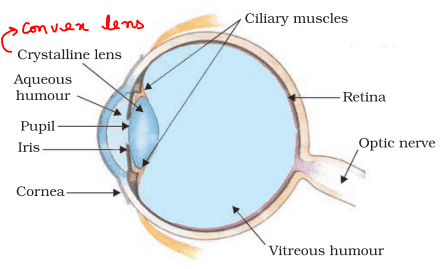
Light enters the eye through a thin membrane called the cornea. It forms the transparent bulge on the front surface of the eyeball. Most of the refraction for the light rays entering the eye occurs at the outer surface of the cornea.
The crystalline lens provides the finer adjustment of the focal length required to focus objects at different distances on the retina.
We find a structure called the iris behind the cornea. Iris is a dark muscular diaphragm that controls the size of the pupil.
The pupil regulates and controls the amount of light entering the eye.
The eye lens (convex lens) forms an inverted real image of the object on the retina.
The retina is a delicate membrane having enormous number of light-sensitive cells. The light-sensitive cells get activated upon illumination and generate electrical signals. These signals are sent to the brain via the optic nerves. The brain interprets these signals, and finally, processes the information so that we perceive objects as they are.
Power of Accommodation
The eye lens is composed of a fibrous, jelly-like material. Its curvature can be modified to some extent by the ciliary muscles. The change in the curvature of the eye lens can thus change its focal length.
- When the muscles are relaxed, the lens becomes thin. Thus, its focal length increases. This enables us to see distant objects clearly.
- When you are looking at objects closer to the eye, the ciliary muscles contract. This increases the curvature of the eye lens. The eye lens then becomes thicker. Consequently, the focal length of the eye lens decreases. This enables us to see nearby objects clearly.
Power of Accommodation: The ability of the eye lens to adjust its focal length is called accommodation.
Near point of the eye:
- The minimum distance, at which objects can be seen most distinctly without strain, is called the least distance of distinct vision.
- For a young adult with normal vision, the near point is about 25 cm.
Far point of the eye:
- The farthest point up to which the eye can see objects clearly is called the far point of the eye.
- It is infinity for a normal eye.
Cataract:
- Sometimes, the crystalline lens of people in old age becomes milky and cloudy. This condition is called cataract. This causes a partial or complete loss of vision.
- It is possible to restore vision through a cataract surgery.
Defects of Vision and Their Correction
There are three common refractive defects of vision. These are
- Myopia or near-sightedness
- Hypermetropia or far-sightedness
- Presbyopia
1. Myopia
Myopia is also known as near-sightedness. A person with myopia can see nearby objects clearly but cannot see distant objects distinctly.
A person with this defect has the far point nearer than infinity.
In a myopic eye, the image of a distant object is formed in front of the retina and not at the retina itself.
This defect may arise due to
- excessive curvature of the eye lens, or
- elongation of the eyeball.
This defect can be corrected by using a concave lens of suitable power.
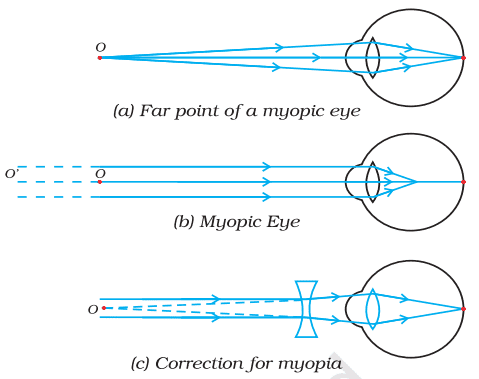
2. Hypermetropia
Hypermetropia is also known as far-sightedness. A person with hypermetropia can see distant objects clearly but cannot see nearby objects distinctly.
The near point, for the person, is farther away from the normal near point (25 cm).
Such a person has to keep reading material much beyond 25 cm from the eye for comfortable reading. This is because the light rays from a closeby object are focussed at a point behind the retina.
This defect arises either because
- the focal length of the eye lens is too long, or
- the eyeball has become too small.
This defect can be corrected by using a convex lens of appropriate power.
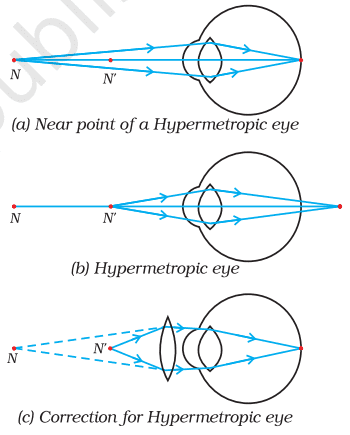
3. Presbyopia
The power of accommodation of the eye usually decreases with aging. For most people, the near point gradually recedes away. They find it difficult to see nearby objects comfortably and distinctly without corrective eye-glasses. This defect is called Presbyopia.
It arises due to:
- gradual weakening of the ciliary muscles
- diminishing flexibility of the eye lens.
Note: Sometimes, a person may suffer from both myopia and hypermetropia. Such people often require bi-focal lenses. A common type of bi-focal lens consists of both concave and convex lenses. The upper portion consists of a concave lens. It facilitates distant vision. The lower part is a convex lens. It facilitates near vision.
Refraction of Light Through a Prism
Consider a triangular glass prism. It has two triangular bases and three rectangular lateral surfaces. These surfaces are inclined to each other. The angle between its two lateral faces is called the angle of the prism.
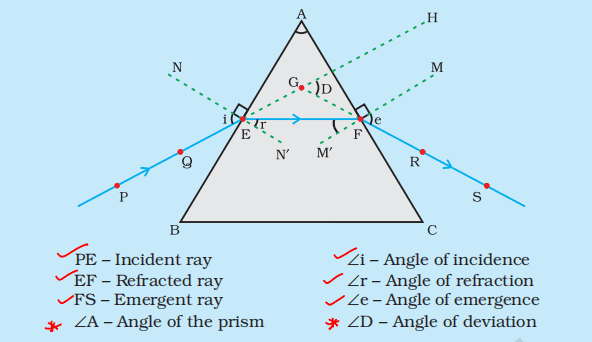
A ray of light enters from air to glass at the first surface AB. The light ray on refraction has bent towards the normal. At the second surface AC, the light ray has entered from glass to air. Hence it has bent away from normal. The peculiar shape of the prism makes the emergent ray bend at an angle to the direction of the incident ray. This angle is called the angle of deviation. In this case, ∠D is the angle of deviation.
Dispersion of White Light by a Glass Prism
When a ray of white light is incident on a glass prism, it splits the incident white light into a band of colors. The various colors seen are Violet, Indigo, Blue, Green, Yellow, Orange, and Red (VIBGYOR).
- The band of the colored components of a light beam is called its spectrum.
- The splitting of light into its component colors is called dispersion.
Why do we get these colors? (Cause of Dispersion of Light)
Different colors of light bend through different angles with respect to the incident ray, as they pass through a prism. The red light bends the least while the violet the most. Thus the rays of each colour emerge along different paths and thus become distinct. It is the band of distinct colors that we see in a spectrum.
Recombination of White Light
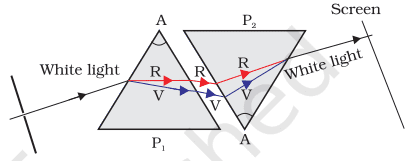
Isaac Newton was the first to use a glass prism to obtain the spectrum of sunlight. He then placed a second identical prism in an inverted position with respect to the first prism. This allowed all the colors of the spectrum to pass through the second prism. He found a beam of white light emerging from the other side of the second prism.
Rainbow Formation
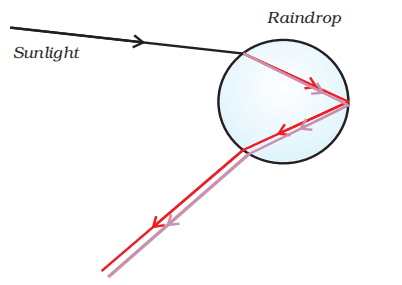
A rainbow is a natural spectrum appearing in the sky after a rain shower. It is caused by the dispersion of sunlight by tiny water droplets, present in the atmosphere. A rainbow is always formed in a direction opposite to that of the Sun. The water droplets act like small prisms. They refract and disperse the incident sunlight, then reflect it internally, and finally refract it again when it comes out of the raindrop. Due to the dispersion of light and internal reflection, different colors reach the observer’s eye.
Atmospheric Refraction
The refraction of light by the earth’s atmosphere is called atmospheric refraction.
The hot air is lighter (less dense) than the cool air and has a refractive index slightly less than that of the cool air.
Twinkling of Stars
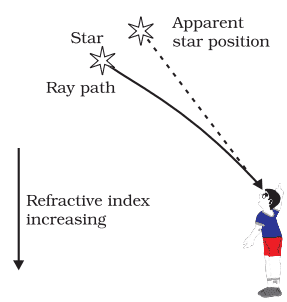
The twinkling of a star is due to the atmospheric refraction of starlight. The starlight, on entering the earth’s atmosphere, undergoes refraction continuously before it reaches the earth. Since the stars are very distant, they approximate point-sized sources of light. As the path of rays of light coming from the distant star varies slightly, the apparent position of the star fluctuates and the amount of starlight entering the eye flickers that is, the stars sometimes appear brighter, and at some other times, fainter, which is the twinkling effect.
Why don't the planets twinkle?
The planets are much closer to the earth and are thus seen as extended sources. Due to this, they appear a combination of large point-sized sources of light, and the total variation in the amount of light entering our eye from all the individual point-sized sources averages out to zero, thereby nullifying the twinkling effect.
Advance Sunrise and Delayed Sunset
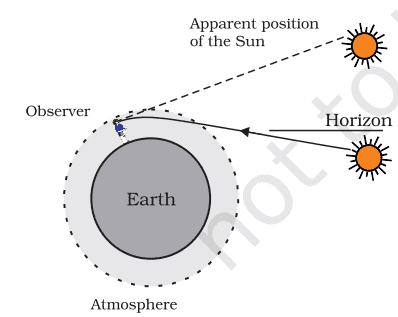
The Sun is visible to us about 2 minutes before the actual sunrise, and about 2 minutes after the actual sunset because of atmospheric refraction.
The time difference between the actual sunset and the apparent sunset is about 2 minutes.
The apparent flattening of the Sun’s disc at sunrise and sunset is also due to the same phenomenon.
Scattering of Light
Tyndall Effect
The Earth’s atmosphere is a heterogeneous mixture of minute particles. These particles include smoke, tiny water droplets, suspended particles of dust, and molecules of air. When a beam of light strikes such fine particles, the path of the beam becomes visible. The light reaches us after being reflected diffusely by these particles. The phenomenon of scattering of light by the colloidal particles gives rise to the Tyndall effect.
Examples:
- This phenomenon is seen when a fine beam of sunlight enters a smoke-filled room through a small hole. Thus, the scattering of light makes the particles visible.
- Tyndall effect can also be observed when sunlight passes through the canopy of a dense forest. Here, tiny water droplets in the mist scatter light.
The color of the scattered light depends on the size of the scattering particles. Very fine particles scatter mainly blue light while particles of larger size scatter light of longer wavelengths. If the size of the scattering particles is large enough, then, the scattered light may even appear white.
Why is the color of the clear Sky Blue?
The molecules of air and other fine particles in the atmosphere have sizes smaller than the wavelength of visible light. These are more effective in scattering light of shorter wavelengths at the blue end than light of longer wavelengths at the red end. Thus, when sunlight passes through the atmosphere, the fine particles in the air scatter the blue color (shorter wavelengths) more strongly than red. The scattered blue light enters our eyes.
If the earth had no atmosphere, there would not have been any scattering. Then, the sky would have looked dark.
The sky appears dark to passengers flying at very high altitudes, as scattering is not prominent at such heights.
‘Danger’ signal lights are red in color: The red is least scattered by fog or smoke. Therefore, it can be seen in the same color at a distance.
Download Class 10 Science Chapter 10 The Human Eye and the Colourful World NCERT Underlined PDF
| Must Read: The Human Eye and the Colourful World Class 10 Important Questions Answers Control and Coordination Class 10 Important Questions with Answers |
| You Might Also Like: CBSE Class 10 Notes CBSE Class 10 Important Questions and Answers |
Hope you liked these notes on Class 10 Science Chapter 10 Human Eye and the Colourful World. Please share this with your friends and do comment if you have any doubts/suggestions to share.
did you miss any detail mentioned in ncert or this is line to line notes
can u pls share notes on our environment